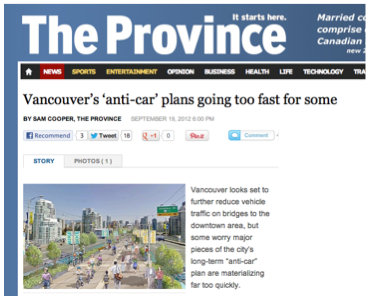So once again:
It’s apparent from the way much of the media frame the story about proposed greenways and bike lanes on the Granville and Cambie Bridges – and certainly from the comments – that some people believe the development of bike lanes and greenways are a zero-sum game: That allocating space for cyclists will come at the expense of vehicles, the result will be intolerable congestion, people will stay away from Downtown, business and goods movement will suffer.
Even though every time we do it, not much happens. If bike lanes were going to have negative economic and congestion effects, wouldn’t we know that by now?
Think of all the things we’ve done since the 1970s – traffic calming in the West End, Granville Mall, resident-only parking, a dramatic drop in surface parking lots (and now the demolition of parkades), parklets, greenways, separated bike lanes – even as the population and jobs downtown have practically doubled. And yet the traffic still flows, trips to downtown increase and quality of life gets better.
Vancouver is cashing in on the singular advantage created because we have had a drop in vehicle traffic (we’re down to 1965 levels) thanks to our land-use policies (more people living downtown), much better transit, and yes, encouragement of walking and cycling. As vehicle use declines, we have more space to accommodate things like bike lanes, which further reduces the space needed for car traffic – a positive loop if there ever was one.
And consequently, there isn’t that big an impact on traffic flow.
So why would we stop now?
_________________________________________________________
.
Fortunately, we’re not. In addition to beginning the process of looking at the bridges, the City is proceeding with plans for the Comox-Helmcken Greenway:
We want to make the route comfortable, enjoyable, convenient, and accessible for all ages and abilities.  Come out to an open house to view the design for Section 1 of the Comox-Helmcken Greenway and provide your comments on the proposed route for Section 2 on:
Come out to an open house to view the design for Section 1 of the Comox-Helmcken Greenway and provide your comments on the proposed route for Section 2 on:
4 October 2012
West End Community Centre, 12-3 pm
English Bay Room, 870 Denman Street
3 October 2012
Coast Plaza Hotel & Suites, 5-8 pm
Barclay Room, 1763 Comox Street
1 October 2011
Engine 374 Pavilion at the Roundhouse Community Centre, 5-8 pm
181 Roundhouse Mews (entrance from the plaza on Davie Street)
29 September 2012
Mole Hill Farmers Market, 9 am-2 pm
Comox Street at Nelson Park (1100 block of Comox Street)
.
UPDATE:
Bike riding up 26% in Metro Vancouver says TransLink
.
UPDATE:
Toderian weighs in: Stop bike lane fight, Vancouver urged
Mr. Toderian bemoaned the fact that bike lanes have become a hot-button issue, noting that biking is merely one pragmatic part of making a city function.
“Only in North America has this become an ideology,” he said, blaming both those who call bike lanes a war on the car and “self-identified cyclists” who don’t help the discussion.
Mr. Toderian, now an independent planning consultant, said bike routes are the only aspect of the city’s entire transportation puzzle that the public and the media tend to talk about.
“Bike lanes are not a fad. They are part of a multi-modal city, a critical part of the city working well in the future.”















The cycling route has been changed to Comox-Drake. The original route ended on Helmcken in Yaletown with a circuituous connection to the seawall on Drake. The missing connection is between the Cambie bridge and the rest of the downtown network – there isn’t a direct designated cycling route that feels safe.
My feedback on this route was that it should make this Cambie-Yaletown connection in addition to the Yaletown-West End connection. It now looks like it won’t do either.
Especially with the proposed bike path on the west side of Cambie Bridge, Nelson would be a much better connection to the Cambie Bridge if it had separated bike lanes. Way back in 1997, bike lanes were included on Smithe and Nelson in the city’s last transportation plan.
Bike lanes do cause congestion and they are $$$ in relative to the small amount of the population who use.
Yes, Peter, the bike lanes are undoubtedly to blame. Why, just imagine how uncongested Highways 1 and 99 would be without those pesky bike lanes. Oh, wait…
As an aside, did that infographic come from the CoV website? I guess none of the $3mil went to a copy editor.